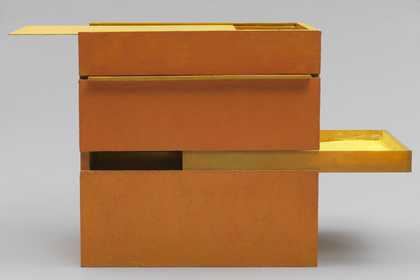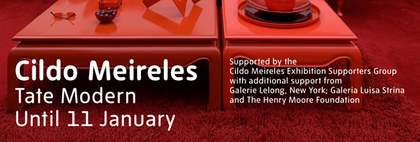Frederico Morais
You’ve moved around the vast territory of Brazil quite a lot, both on your own and with your family. You were born in Rio de Janeiro in 1948 and have also lived in Goiânia, Belém, Brasília, Planaltina, Salvador, Paraty, Petrópolis, São Paulo and Alcântara. In 1969–70 you made a series of works that you generically called Arte Física (Physical Art). It included such pieces as Mutações Geográficas: Fronteira Rio/São Paolo (Geographical Mutations: Rio/São Paulo border), which consisted of making a hole on each side of the border, exchanging the soil, plants and debris from the two holes and then placing the remainder in a leather case that reproduced the topographical pattern of the border, and 1969’s Cordões/30km de Linha Estendidos (Cords/30km Extended line), which involved laying string along 30 kilometres of beach front and then collecting what was left of it. Do these works have anything to do with having moved around so much?
Cildo Meireles
No one has ever moved around enough to say they know Brazil. In my case, the result of those moves was specific experiences that became important to me – things that were different from one another yet had something in common, an experience of our Brazilian reality which was an important, albeit modest, part of my education. One of them was realising that certain characteristics of Brazilian art – economy of materials, power of synthesis and a good deal of its creative potential – refer to the country’s very socio-economic and cultural precariousness.
Frederico Morais
Why the title Arte Física?
Cildo Meireles
Because the works move through the country’s physical geography – territorial expanses, borders, geology, water, fire, etc – the manipulation of which requires the presence of the artist’s body, as in Cordões/30km de Linha Estendidos. Or they involve transferring materials and objects from one border to another, or building a fire, and so on. It’s a dialogue between body and material – although both are raw materials.
Frederico Morais
Is it an attempt to capture and understand our geographical diversity, or even a utopian desire to redesign the map of Brazil?
Cildo Meireles
Well, there was some youthful hubris about it, although it was also about trying to understand Brazilian politics and history. In a report on Brasília which he wrote as a complement to his urban project for the city, the Brazilian architect Lúcio Costa says it was ‘born of the primary gesture of one who marks or takes possession of a place: two axes crossing at right angles: the very sign of the cross’. Arte Física: Caixas de Brasília/Clareira (Physical Art: Brasília Boxes/Clearing) from 1969 was an attempt to create and take possession of a free territory. This piece consisted of a quadrilateral made from string attached to wooden stakes that was laid out on the ground on the banks of Lake Paranoá, in Brasília. The material (leaves, twigs, etc) was gathered from within this area, piled up in the middle of it and burned. The next day, a hole was dug beside the extinguished fire. Some of the ashes from the fire were placed in a 30 x 30 x 30 cm wooden box. Some of the earth which had been dug from the hole was placed in a second box. The remaining ashes and some earth were placed in a third box. This was later placed inside the hole and covered with earth. And in spite of the fact that the act was more symbolic than real, even though it materialised in the box-receptacle which contained residue from the fire – ashes, earth and leaves, in addition to the two stakes and the cordon which demarcated the space of the event – in order to carry it out I had to deal with the repression coming from the Brasília Tower, which was a panoptical tower used by the military regime as an instrument for controlling the city and its dwellers.
Frederico Morais
After seeking to express the country’s monumental scale in your works, you changed to a minimalist scale. For example, in one of the Condensados (Condensations) series, 1970’s Condensados I – Deserto (Condensations I – Desert), a single grain of sand is set inside a gold and white sapphire ring, while Cruzeiro do Sul (Southern Cross) 1969–70 is a 9mm wooden cube (made of segments of oak and pine woods sacred to the indigenous Tupi of Brazil) which can be balanced on a fingertip.
Cildo Meireles
As a personal experience, it was an exacerbation of the physical problem of space: the uncomfortable yet stimulating sensation of being situated in between the infinitely small and the infinitely large. After all, explosion is the limit of compression. Or, to put it another way, all compression generates explosion. In my art, it is precisely the smallest works which are the most comprehensive. As Guy Brett wrote about the installation of Cruzeiro do Sul: ‘The space that dwarfs the object is also creating its potency.’
Frederico Morais
From the age of nine to nineteen you lived in Brasília. How did that city impact on your development as an artist and a citizen?
Cildo Meireles
The Centro Integrado de Ensino Médio (which was associated with the University of Brasília) offered film, visual arts, literature and music courses and expanded my interest in those subjects. Furthermore, I was able to use the Universidade de Brasilia library, which carried most of the latest European and North American art magazines. On the other hand, because of its radial position, added to its being a political capital, Brasília communicates with the country’s various regions, which was very stimulating. There was a formidable integrating strength among the inhabitants of the emerging city, which was undoubtedly extremely important in making me who I am today, as a citizen and as an artist.
In the early years of my artistic activity, I drew tirelessly. In the beginning, I was hugely influenced by African art, which I saw at an exhibition that had travelled to Brasília in 1963, when I was fifteen. What I found attractive about it was its extreme elegance, synthetic capacity and economy of form. But the new political situation slowly began to affect everybody and everything, including my drawings, in which the masks began to resemble military helmets. It was at that point I decided to isolate myself, as an artist, polishing my draughtsmanship the way one might clean a glass slide after it’s been analysed by a lab technician. From that moment on, my greatest concern was the investigation of spatial relations. That was when the drawings on graph paper which made up the Espaços Virtuais: Cantos, Volumes Virtuais (Virtual Spaces: Corners, Virtual Volumes) and Ocupações (Occupations) series were born (from 1967 to 1970). Based on Euclidean principles of space, they used three planes to define a figure in space. They were originally meant to be drawn on graph paper, with versions made of wood or wool thread. Some were constructed into three dimensions as a corner of a typical room. I had a good education in mathematics and geometry – subjects I was always drawn to on account of their aesthetic potential: beauty, precision and poetry. However, the Espaços Virtuais: Cantos revealed my need to isolate and concentrate on questions of a formal nature without interference from emotional noises external to the work.
I also participated in political events as a citizen, not as an artist, and continued to do so after I moved to Rio de Janeiro. These included the funeral of student Edson Luis, who was assassinated by the dictatorship, and the March of One Hundred Thousand while working on the first three Cantos (Corners). Making up a single group, which I called Nowhere is my home, these were exhibited at the Salão da Bússola in 1969, and in the show of Brazilian works selected for the Paris Biennale, which was cancelled by the military government and led to an almost ten-year international boycott of the São Paulo Biennial – something which undoubtedly affected the Brazilian art scene.
Frederico Morais
In 1970 you started a series of works called Inserções em Circuitos Ideológicos (Insertions into Ideological Circuits), based on an investigation of society’s mechanisms for circulating information and manufactured products. How did this series come about?
Cildo Meireles
While having a beer with a friend at a bar in Rio, he remarked that an olive stone could never be removed from a bottle unless the mechanical process for washing bottles was changed. As I pictured this olive stone inside a bottle, I concluded that there are circulation mechanisms within society which could be used by artists as counter-information. Newspapers, radio and television are circuits for transmission with a very broad reach, yet they are vulnerable – that is to say, they are easily controllable. So on 13 January 1970 I started putting insertions into newspapers. I placed a small advertisement in the Jornal do Brasil which read simply: ‘Área 1, Cildo Meireles, 1970.’ On 3 June 1970 I published another small ad which read: ‘AREAS – Vast. Wild. Faraway. Letters to Cildo Meireles, Rua Gal. Glicério, 445, apt. 1003, Laranjeiras, GB.’ It was a reference, among others, to the threat of the occupation of the Amazon by foreigners. Yet there were other circuits, some of which were created spontaneously, such as the chain letters which promise to bring good luck and money, and others that already existed, such as returnable beer or pop bottles and paper currency, both of which could be used as supports for new forms of intervention. The two earliest insertion projects involved banknotes and recyclable glass Coca-Cola bottles, dated April and May 1970. For Inserções em Circuitos Ideológicos: Projeto Cédula (Insertions into Ideological Circuits: Cédula Project) I rubber stamped a one cruzeiro note with the question: ‘Who killed Herzog?’ This referred to the suspicious death in prison of the journalist Wladimir Herzog. For Inserções em Circuitos Ideológicos: Projeto Coca-Cola (Insertions into Ideological Circuits: Coca-Cola Project) I took some Coca-Cola bottles, printed ‘Yankees Go Home’ on them and then put them back in circulation. The replacement of the paper money and the bottles containing inscriptions (whether handwritten, rubber stamped or printed) made by their users proved too costly for the companies and the state. Because it was globalised, the Coca-Cola circuit was the more charming and ideologically efficient.
Frederico Morais
Since art is often itself part of a circuit, shouldn’t it motivate new Inserções?
Cildo Meireles
The insertions are a negation of authorship, of copyright. They aren’t works of art, they are propositions for action and participation. Nor are they a form of multiplied art – or whatever you want to call that (multiples, editions, etc). I never sold any of my Inserções em Circuitos Ideológicos. Anyone can make them, albeit not for commercial purposes. Actually, the Inserções bothered me. At the time I thought that the artist’s problem was not whether or not to be in the São Paulo Biennial, for example. The problem was: could my work be in the biennial? Could I explain the Inserções being part of museum collections, as works of art? I soon understood, though, that they weren’t even souvenirs or editions. They were actually examples of action. So, in spite of the impasse, I continued to create works. After all, conflict is the best camouflage.
Frederico Morais
In one of the variations of the Coca-Cola project, you record the formula for making a Molotov cocktail. With the aid of photographs and slides, you teach people how to engrave inscriptions such as ‘Yankees Go Home’, or how to make the handbills. In giving up authorship, proposing plagiarism or anti-copyright, what is your intention?
Cildo Meireles
My works are based on language. I try to distance myself from a pathological approach to art; that is, art as its author’s autobiography. Only an artist with a truly extraordinary history can produce autobiographical work that is worthy of interest. I prefer to think that some of my works can be made by anyone, at any time, in any place.
Frederico Morais
How did you and your generation relate to the Brazilian artists who came before you?
Cildo Meireles
I have trouble dealing with the idea of generations characterised by cohesive groups of artists acting at a given time. Regardless of generations and groups, I’ve created a genealogy for myself that would include the following artists. 1 – Antonio Francisco Lisboa, the Aleijadinho (1730–1814). Aleijadinho is Portuguese for ‘little cripple’. He was a sculptor, carver of reliefs and architect, and is considered to be the most important artist of the Brazilian colonial period, his work situated stylistically between the Baroque and the Rococo. His work never ceases to move me. 2 – Oswaldo Goeldi (1895–1961), a formative element of my work, ever since my father gave me a book of his woodcuts and drawings when I was a boy. 3 – Alfredo Volpi (1896–1988), who made precariousness one of the triumphs of his painting. 4 – Lygia Clark (1920–1988). 5 – Hélio Oiticica (1937–1980). 6 – specific works by Aluísio Carvão (1920–2001), such as Cubocor (Colour Cube) and his Farfalhantes (Rustling works) series. The Farfalhantes (picture-objects) were constructed with bottle caps that moved when touched by the wind or breath, creating sounds. 7 – Raimundo Colares (1944–1986).
Frederico Morais
The critic Guy Brett singles you out as a pioneer of Conceptual art on a global level. Remembering that when you participated in ‘Information – Summer 1970’ at the Museum of Modern Art, New York, you were only 22 years old and had never held an exhibition abroad, what do you feel about the application of the title Conceptual art to your work?
Cildo Meireles
The term can’t be applied generically, but surely some of my works may read conceptually. It is also certain that from the end of the 1960s – in light of certain exhibitions held in Brazil and abroad – international critical opinion of Brazilian art began to change. This trend was intensified in the 1970s and 1980s with the publication of books, essays and articles in Europe and in the United States containing pertinent critical analyses of new Brazilian art. It was during this period that new Brazilian artists began to appear on the international scene alongside some of the already historical figures of our avant-garde, such as Lygia Clark and Hélio Oiticica. Their work possesses a different nature from that of other vanguards, particularly when it is founded on the political perspective. It is a very eloquent difference when confronted with Euro-North-American Conceptual art of that time.
Frederico Morais
In Brazil and the other Latin American countries, the emergence of Conceptual art coincides with military dictatorships. Do you think the political situation is the motivating element of your generation – to many, the Brazilian generation of Conceptual art?
Cildo Meireles
It’s always hard for me to talk about generations, and it’s even harder because I’m talking about myself. Conceptual art reveals a great deal of generosity by affirming anyone’s ability to make art, even when deprived of economic or technical conditions. In other words, early on, Conceptual art allowed Brazilian precariousness to be appropriated on various levels as a positive factor for formal creativity. It is not, however, a matter of aestheticising poverty, but of giving a voice to a multitude of individuals. Not all the artists in my generation were conceptual and not all the works were intentionally political. I can say the same of my own work. I despise any form of pamphleteering in art, which is the risk we run when art is politically biased. So I don’t think the political situation was my generation’s motivating element, and even less so in my case. I do, however, acknowledge that some of my work is political. For example, 1971’s Tiradentes: Totem-Monumento ao Preso Político (Tiradentes: Totem-Monument to the Political Prisoner) is. For this piece I tied ten hens to a white wooden post and set them on fire. (Joaquim da Silva Xavier, known as Tiradentes, who organised the first uprising against the Portuguese rulers, was hung, drawn and quartered in 1792.) While my works are not politically motivated, they may become political at certain moments, or under certain circumstances – regardless of my will. When I made my first Inserções em Circuitos Ideológicos I stopped drawing for about five years. At that point, I was living in New York (1971–3) and went to see an exhibition of Matisse’s work at MoMA. My eyes welled up. I began to rethink the importance of art and to reflect on the role played by museums in the democratisation of culture.
Frederico Morais
Brett says there’s a domestic vein running through your work and gives several examples of this: the lit candle in the installation Volátil (Volatile) 1980–94 or the matchboxes in 1979’s Fiat Lux, O Sermão da Montanha (Fiat Lux, the Sermon on the Mount), which in fact contains 126,000 Fiat Lux matchboxes. You have also used chairs, tables, razor blades, squeegees, paper bags, paper money, radios, carpenter’s rulers and pins. In your work, these objects – adjusted, related and accumulated – are transformed into receptacles for social and intellectual content. They might not achieve the condition that Gaston Bachelard writes about as ‘subject-objects’ or Violet Morin describes as ‘biographical objects’. They didn’t belong to you or grow old beside you. None the less, together they make up elements of your biography.
Cildo Meireles
Well, no work resists autobiography. I try to establish a repertoire of objects which are simultaneously substance and symbol – a familiar repertoire. The squeegee (to give just one example) is part of the lives of thousands of people, but there is a moment in which the objects are articulated, revealing their privacy. In other words, there is an internal, constitutive order, which is invisible.
Frederico Morais
A great many of your works contain two dates, the first corresponding to some notation in a page of your countless notebooks, the second referring to its finalisation. Could you describe the trajectory from note-taking to the final work?
Cildo Meireles
I record my ideas as drawings, images, words, outlines, clippings. I create mental landscapes which materialise through the gathering of complementary things, sensations, feelings and information. The installation Através (Through) 1983–9 was born from the sound and visual perception of a sheet of cellophane being crumpled into a ball, which had been tossed into a waste paper basket. I used shards of glass being trodden upon in my initial attempt to transpose that perception of sound to the field of art. I then added observations about the surroundings of my mother’s home on the outskirts of Brasília – the way barriers began to appear between the houses (which originally communicated freely with one another), mixing and narrowing the boundaries between the front and back yards, successions of doors and construction site fences, creating narrow, claustrophobic corridors. Através is about those limits, impediments and boundaries which – even though they are resistant – do not prevent the gaze from piercing them. The cellophane ball in the centre of the structure is the only item which the gaze does not pierce. Ultimately, artistic creation is a sarapatel [a highly spiced stew made with blood, pork or lamb tripe and giblets; colloquially, it signifies pandemonium, a disordered mixture of things, a mess]. It mixes everything up: images, sounds, memory… Once the initial idea has been jotted down, it is fed by all sorts of information: observations of everyday life, the history of art, mathematical theorems, the laws of physics, things one has read. The idea that led to Devio para o vermelho (Redshift) came to me in 1967. The very first of my notes indicates that I was thinking about this piece as blue. But red took over until it had completely impregnated the surfaces of the various objects – like a colour poem. The final form comprises three autonomous spaces which I came up with at different times, albeit endowed or linked by an internal logic which eventually creates a circular narrative. And yet it wasn’t until seventeen years later that I began to execute the final work. Curiously enough, I was helped by a tabloid called Balcão, which is devoted exclusively to classified ads – you could pretty much buy or sell anything in it. The paper ran a front-page headline announcing my interest in exchanging or buying objects in the colour red.
Frederico Morais
You have been influenced by other cultural sources. You named your second son Orson in honour of Orson Welles, who directed and starred in one of your favourite films, The Lady from Shanghai (1947). And you have referred to his radio broadcast announcing the invasion of Earth by extraterrestrials as the precocious apex of his career.
Cildo Meireles
That’s all true. I consider the 1938 radio broadcast of War of the Worlds to be one of the most important art objects of the twentieth century, alongside Marcel Duchamp’s readymades and Piero Manzoni’s Base of the World 1961. In 1965, when I was still living in Brasília, I became tired of just drawing and decided to attend film courses at the CIEM. In those days my greatest interest was animated films, by Peter Foldes, Norman McLaren, Jiri Trnka and Bretislav Pojar. But I concluded that film wasn’t my dream and I returned to the visual arts. In the 1960s I designed costumes and scenery for a theatrical production of Kafka’s In the Penal Colony. I might add that my second son’s name is Orson Joaquim and that it therefore contains a homage not just to Welles, but also to Joaquim da Silva Xavier, and to the admirable Joaquim Cruz, the Brazilian long-distance runner and Olympic champion born in Brasília.
Frederico Morais
And who are your main influences in literature?
Cildo Meireles
When it comes to literature I am absolutely chaotic. My father was a bibliomaniac, drawn to Portuguese writers or texts on indian and Amazonian subjects related to his activities as an ethnologist specialising in the study of indians. He spent his weekends cleaning his books, which he purchased at great expense. He was a humble public servant who had to sell off his library three times in order to pay debts. My list of favourite writers would have to include Kafka, Rimbaud, Henry Miller (at certain moments), the American mathematician Norbert Wiener and two Argentinian writers, Jorge Luis Borges and Julio Cortázar.
Frederico Morais
So you put writers and scientists on the same level, and among the former you choose authors who deal with paradoxes, enigmas, labyrinths, mirror games and the absurd…
Cildo Meireles
That’s true. Literature has influenced me more than film, although my choice of reading material has always been erratic.
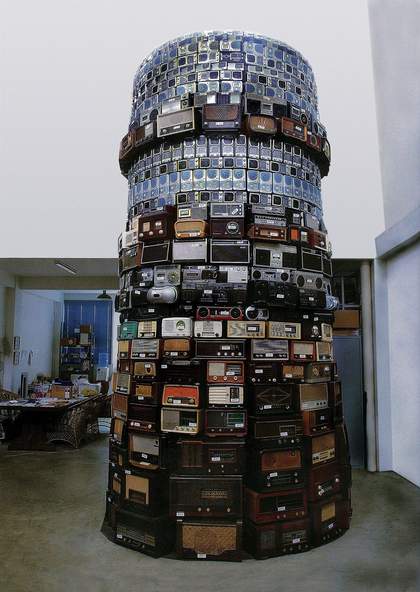
Cildo Meireles
Babel 2001
Radios, metal
300 x 500 cm
Presented by the American Fund for the Tate Gallery 2007
Frederico Morais
What about music?
Cildo Meireles
I’ve loved music ever since I was a boy. It frames significant moments and events in my life.
Frederico Morais
Several works have been created with or are based on materials producing sound.
Cildo Meireles
Yes. A lot. In 1971’s Tres Sonidos (Three Sounds) I used two pairs of emery boards to produce sound. In Eureka/Blindhotland 1970–5 rubber balls of variable weights were dropped on the floor from different heights. Also there is the sound of switched on television sets in For Pedro 1984–93, while Liverbeatlespool, which I presented at the Liverpool Biennial in 2004, is about the music of The Beatles. In some cases, it’s just a cacophony, as in Marulho (The Surge of the Sea, 1991–7), in which the sound of the word ‘water’ is repeated by men and women in different languages. In Babel 2001–6 and Blahbahblah 2001 I used radios and cell phones, respectively. I also used LP records as sound sculptures in Mebs/Caraxia (Mobius Strip/Spiral Galaxy 1970–1 and 1975’s Sal sem Carne (Salt without Meat).
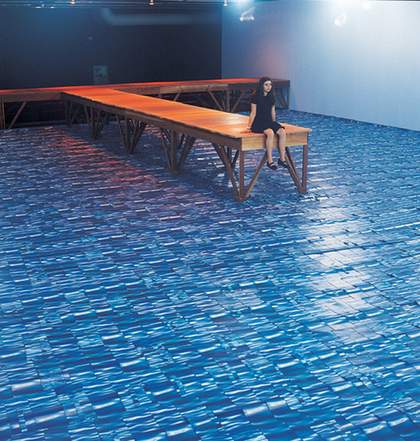
Cildo Meireles
The Surge of the Sea 1991–7
Installation view at the Museum of Modern Art, Rio de Janeiro
Wood decking, books, soundtrack
Photo: Wilton Montenegro
Frederico Morais
You have spoken about your admiration for the work of Roman Opalka, Daniel Buren, On Kawara and Giuseppe Penone, all of whom are obsessed with certain subjects. For Opalka, painting is a process of counting and he has spent his life painting numbers in ascending order. Each new canvas takes up counting where the last left off. On Kawara has made a long series of ‘date’ paintings – each day a painting of that day’s date. It is an admiration which is hard to explain because your own creative work is the opposite of that.
Cildo Meireles
I could never restrict myself almost religiously to certain subjects or procedures. Nor could I give up the freedom to experiment with new materials, procedures, or questions. Whenever I begin a new work, I always prefer the risk of starting from scratch. Sure, we’re always influenced by what we did before, just as, in a way, we’re always influenced by what other artists we admire have done or still do. We’re all a bit like snails, carrying around our house, our universe.
Frederico Morais
Which artists do you feel an affinity with, or have influenced you in different ways?
Cildo Meireles
Chronologically, I would start with the Spaniards: El Greco, Velázquez, Goya. In the beginning, when I was almost exclusively devoted to drawing, I studied Goya’s graphic work intensively. I was very young when my father gave me a book about his prints. And in international contemporary art, Marcel Duchamp, obviously; Piero Manzoni, an admirable artist whose work I am immensely fond of; Yves Klein, Gordon Matta-Clark, Walter de Maria and Chris Burden. And I nearly forgot Edward Hopper. Duchamp and Manzoni excepted, what I am attracted to in the others are specific works. In my opinion, Yves Klein’s Immaterials series is one of the great moments in the history of contemporary art. Sometimes it’s not a particular work, but the thoughts and sensations that permeate its creation. In Walter de Maria, for instance, I am attracted to the essentiality, the grand solemnity of certain works that are based on things or gestures as simple as making a hole in the ground. His work exemplifies a quality I admire in the art of the United States: the notion of scale – a scale attuned to the country’s territorial expanse.
Frederico Morais
You recently paid tribute to Manzoni at Herning Park in Denmark by standing upside down on his Socle du Monde plinth. Like so many of your works, the title you gave the tribute – Atlas – is wonderfully ironic, inasmuch as you invert the mythological character’s performance. I can see an affinity with Manzoni in other works such as Cordões/30km de Linha Estendidos, which relates to his 5.12 Metre Line 1959, and Ku kka Ka kka (made with excrement) and Manzoni’s Merda d’artista 1961. You have joked that you purchased several cans of Merda d’artista to use for the Ku kka Ka kka installation. Yet in spite of your avowed admiration for Duchamp, you’ve never paid explicit tribute to him. Or have you?
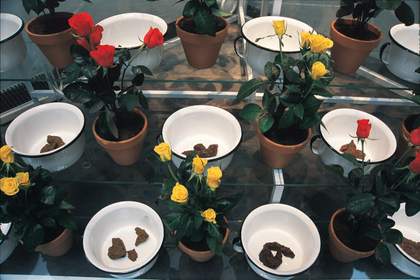
Cildo Meireles
Ku kka Ka kka 1992/1999
Installation view at the Museum of Contemporary Art Kiasma, Helsinki
Photo: Central Art Archives/Petri Vertanen
Courtesy Contemporary Art Kiasma, Helsinki
Cildo Meireles
Certainly! For instance, one of the references in my installation Fontes (Fountains/Sources) is Duchamp’s Three Standard Stoppages 1913–14.
Frederico Morais
Do you agree with some analyses which situate Duchamp’s readymades and your Inserções em Circuitos Ideológicos in opposite camps?
Cildo Meireles
Well, the Coca-Cola bottle project is a readymade, as is the one cruzeiro note from the banknote project. The two concepts aren’t antithetical. There are no opposite meanings with the readymades and the Inserções em Circuitos Ideológicos – there are different directions. The readymade might be simplistically defined as a product which, extracted from its industrial series, is reified through the artist’s subjective intervention and, as such, it remains in its condition as a unique work of art with authorial characteristics. Which allows for its museological recovery. The Inserções em Circuitos Ideológicos travel in a much larger flux, adding information that is capable of generating ‘counter-information’. You could call them handmade because they transform the readymade object into something else. They should be regarded as art actions rather than art objects. They are characterised by interactivity. They are meant to be plagiarised – as action. And if, by chance, they wind up in museums, they will be there as examples of actions accompanied by precise instructions on how to act.
I believe that art must be disassociated from the casual. It must be spoken of as highly sophisticated and anticipatory moments of things that are going to happen. Art must be separated from ignorance, yet it must not ignore ignorance. Art must be separated from superficialities, and yet it mustn’t scorn superficiality. One must stop being ‘bête comme un peintre’, to use Duchamp’s phrase. I like how Carl Andre put it. He said: ‘A man climbs a mountain because it’s there. A man makes a work of art because it isn’t there.’

